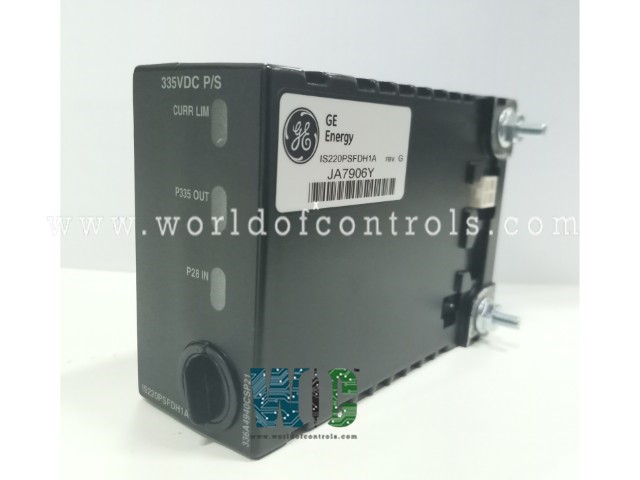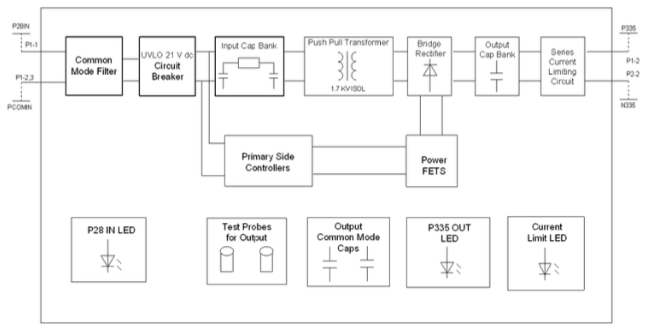
World Of Controls understands the criticality of your requirement and works towards reducing the lead time as much as possible.
IS220PSFDH1A - Flame Detector Power Supply is available in stock which ships the same day.
IS220PSFDH1A - Flame Detector Power Supply comes in UNUSED as well as REBUILT condition.
To avail our best deals for IS220PSFDH1A - Flame Detector Power Supply, contact us and we will get back to you within 24 hours.
SPECIFICATIONS
Part Number: IS220PSFDH1A
Manufacturer: General Electric
Series: Mark VI
Product Type: Power Supply 335 VDC
Maximum Input Voltage: 29.4 V dc
Under Voltage Lockout (UVLO) Range: 22.1–26.4Vdc
Inrush Current Limit: 550 mA for 40 uS, 300 mA steady state
Output Over Voltage Protection: 385 V MOV
Voltage Isolation, Output to Input: 1700 V dc
Ambient Rating for Enclosure Design: -30 to 65oC (-22 to 149 oF)
Availability: In Stock
Country of Origin: USA
Manual: GEH-6721_Vol_II_BP
IS220PSFDH1A is a Flame Detector Power Supply manufactured by General Electric as part of the Mark VI Series used in gas turbine control systems. The primary gas turbine trip protection (TRPG) terminal board is normally mounted above the Flame Detector Power Supply (PSFD). A power distribution board provides 28 V dc as the source power (JPDL). 335 V dc, 5 mA is the output's rated rating. Up to eight flame detectors can be powered by three power supplies linked in a diode-ORed, TMR arrangement to the TRPG's J3, J4, and J5. Should the other two power supplies fail, each supply has enough power to operate all eight flame detectors.
The PSFD's primary characteristics are as follows:
1. Convectional cooling, which uses no cooling fans
2. The ambient temperature is between -30 and 65 °C (-22 to 149 oF)
3. Input of 28 V dc 5% (26.6 to 29.4 V dc)
4. Unregulated output varies by 5% depending on the input (318 to 352 V dc)
5. Isolation at 1700 V DC
6. Protection against output over-voltage
7. A 335 V dc attenuated test point pair Output
8. Three troubleshooting LEDs
9. External diodes can be used to diode-OR the outputs.
10. A 7 mA dc output current limit
11. The inrush current for soft start hot swap input is capped at 550 mA.
12. Input filtering minimizes the sensitivity to input interference and limits emissions.
INSTALLATION OF FLAME DETECTOR POWER SUPPLY
OPERATION:
The PSFD converts 28 V dc to 335 V dc. Current-limited and hot-swap compatible, the 28 V dc input. Transformer isolation separates the floating output from the input. A fixed ratio push-pull converter with an unregulated switching architecture is used. The input is also hot swappable, and the input and output are both current limited.

Fig 1: Power Supply Block Diagram
This 25 kHz switching power supply architecture is push-pull with no feedback or an open loop. According to the input voltage, the output rises and falls. The push-pull transformer has a 1:12 turns ratio to increase the 28 V dc input to 336 V dc. Diode drops further reduce the output voltage by 1.5 V dc, leaving 334 to 335 V dc. Because the power stage's current capacity is substantially higher than the necessary load current, the load control is still good even in this open loop design.
Both overcurrent and inrush current is protected by the input circuit breaker. The breaker modulates a series pass FET on and off during current limiting to reduce power loss. If connected to a P28 V dc bus that is active, the PSFD can be hot-plugged and won't interfere with other delicate loads. The fast-acting circuit breaker stops a short circuit from spreading across the 28 V dc bus if a circuit failure and short circuit happen downstream of the circuit breaker. The 28 V dc bus's exposure to noise is decreased by an EMI filter. After the input connector, a 33 V transform shields the PSFD from voltage spikes and errant reverse bias connections.
Even during a direct short, the output limiter limits the current to 7 mA. Even in an environment that is 65 °C (149 °F), the output can remain shorted indefinitely. At the output, transient protection is provided by a 385 V MOV.
DIAGNOSTICS:
A differential pair of test points allow for the local monitoring of the output voltage. A 100:1 attenuator that is referred to as the chassis for security connects the positive and negative test points to the positive and negative outputs, respectively. There is no risk of electric shock when touching any test site. In addition, a permanent short to the chassis is possible at each test point. Both TP POS (inboard) and TP NEG are used to identify the test points (outboard). Rotating the top round plastic cover will allow you to reach the test spots.
Three status LEDs are seen on the PSFD:
The input and output LEDs only signal the existence of input or output voltage and do not represent any specific voltage level. Similar to the voltage limit LED, the current limit LED does not measure the over-current magnitude and is just intended to serve as an indication. The signal path for the activation signal and the current limit LED are connected in series. In the event that the current limit LEDs malfunction open, a circuit gets around the LED and the limiter keeps working.
Each PSFD's output voltage is attenuated and detected on the TRPG terminal board. The PTUR I/O pack continuously monitors the measured voltage. An alarm is announced in the ToolboxST program or Alarm Viewer in a TMR system if any one of the three PSFDs cannot supply 335 V dc.
WOC has the largest stock of GE Speedtronic Mark VI Replacement Parts. We can also repair your faulty boards. WORLD OF CONTROLS can also supply unused and rebuilt backed up with a warranty. Our team of experts is available round the clock to support your OEM needs. Our team of experts at WOC is happy to assist you with any of your automation requirements. For pricing and availability on any parts and repairs, kindly get in touch with our team by phone or email.
FREQUENTLY ASKED QUESTIONS
What is GE Mark VI IS220PSFDH1A?
It is a Flame Detector 335 VDC Power Supply.
What is an IR flame detector?
Detectors of infrared flames operate in this spectral region.
What is the range of the flame sensor?
Flames with a wavelength between 760 and 1100 nanometers can be detected by the Fire or Flame Sensor Module.